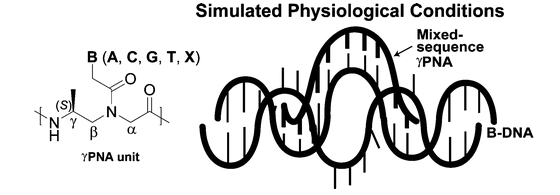γ-peptide nucleic acids (γPNAs) G-Clamp Applicaton
Peptide nucleic acids (PNAs) make up the only class of nucleic acid mimics developed to date that has been shown to be capable of invading double-helical B-form DNA. Recently, we showed that sequence limitation associated with PNA recognition can be relaxed by utilizing conformationally preorganized γ-peptide nucleic acids (γPNAs). However, like all the previous studies, with the exception of triplex binding, DNA strand invasion was performed at relatively low salt concentrations. When physiological ionic strengths were used, little to no binding was observed. On the basis of this finding, it was not clear whether the lack of binding is due to the lack of base pair opening or the lack of binding free energy, either of which would result in no productive binding. In this work, we show that it is the latter. Under simulated physiological conditions, the DNA double helix is sufficiently dynamic to permit strand invasion by the designer oligonucleotide molecules provided that the required binding free energy can be met. This finding has important implications for the design oligonucleotides for recognition of B-DNA via direct Watson–Crick base pairing.

Introduction:
Double-helical DNA has traditionally been considered as a relatively static molecular entity, specifically designed for the storage and safeguard of genetic information.1 Early theoretical estimations2 and nuclear magnetic resonance (NMR) imino proton exchange studies3,4 placed the probability of internal base pair opening right around 10�5, the open base pair lifetime around 10�7 s, and the base pair activation energy in the range of 43�65 kJ/mol at ambient temperature. These initial estimates cast a grim outlook on the prospect of being able to access the Watson�Crick (W�C) hydrogen bond donors and acceptors of nucleobases for recognition. As a consequence, efforts to establish sequencespecific interactions with double-stranded DNA (dsDNA) in the past have generally been focused on chemical groups that reside in the minor5 and major6,7 grooves, in large part, because of the ease of accessibility and the precedence for their recognition in nature. However, over the past two decades, peptide nucleic acids (PNAs),8 a particular class of nucleic acid mimics comprising a pseudopeptide backbone (Chart 1a, top), have been shown to be capable of invading dsDNA.8�10 This finding was significant because, contrary to the traditional belief, it demonstrates that W�C base pairing interactions can be established with intact dsDNA at physiological temperature. Though they are promising as antigene reagents, because of the generality and specificity of recognition, the originally designed achiral PNAs can recognize only homopurine11 and homopyrimidine targets.12 Mixed-sequence PNAs can invade topologically constrained supercoiled plasmid DNA13,14 and structurally perturbed regions of genomic DNA;15 however, they are unable to invade linear, double-helical B-form DNA (B-DNA).
Recently, two approaches, tail clamp16,17 and double-duplex invasion,18 have been developed, allowing mixed-sequence PNAs to invade B-DNA. However, they are not without limitations. The first approach still requires a homopyrimidine tract for anchoring the triplex binding, while the second approach, although more relaxed in sequence selection, is complicated by the need to use two separate strands of pseudocomplementary PNA to invade dsDNA. More recently, we showed that sequence restriction can be relaxed by utilizing conformationally preorganized γPNAs as molecular reagents (Chart 1a, bottom).19 However, like all the other studies, with the exception of triplex binding by homopyrimidine PNAs,20 strand invasion of linear double-helical B-DNA was performed in buffers containing relatively low salt concentrations.11,18,19,21,22 When physiological ionic strengths were used, little to no binding was observed.23 On the basis of this result, it was not clear whether the lack of binding is due to the lack of base pair opening (accessibility) or the lack of binding free energy, because the kinetics of base pair breathing and the thermodynamic stability of the DNA duplex are tightly coupled. Knowing the answer to this question is important because it will tell us whether W�C recognition is a viable option for targeting mixed-sequence B-DNA under physiological conditions. If the former is true, there is little that can be done from a design standpoint. However, if the latter is true, this issue could be resolved through molecular design. Herein, we show that it is the latter. Under simulated physiological conditions, the DNA double helix is sufficiently dynamic to permit strand invasion by the designer oligonucleotide molecules provided that the required binding free energy can be met.
Click on PDF to read more about gamma PNA